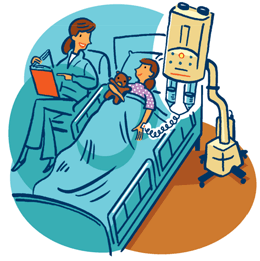Single photon emission computed tomography (SPECT) is a test that detects blood flow changes in the brain. During a seizure, blood flow is highest at the point in the brain where the seizure starts. The SPECT scan shows this “hotspot” in the brain. It will help the doctors plot a course for surgery that will avoid critical areas of the brain, if epilepsy surgery is an option for your child.
To capture images of the blood flow in the brain, SPECT uses a liquid known as a radiopharmaceutical (RAY-dee-oh-far-ma-SOO-tick-ool), a tracer or dye that shows up under a special kind of x-ray called a CT scan. The liquid has very small amounts of radioactive molecules in it, but is safe and will not hurt your child. The liquid is given through an IV that will be placed when your child is admitted to the Epilepsy Monitoring Unit (EMU). Once it reaches the brain, it sends signals that can be read by the SPECT scanner and made into the pictures that the doctors will review.
Before your child’s epilepsy surgery, two SPECT scans will be needed: One, called an ictal (ICK-tull) scan, will be done while your child is having a seizure, and the other, called an interictal (IN-ter-ICK-tull) scan, will be done when your child is not having a seizure. The images of these scans will be compared by the nuclear medicine specialist and your child’s epilepsy specialist.
To get the ictal SPECT (during the seizure), your child’s epilepsy medication will be lowered or stopped so that your child will have a seizure. The procedure is done in the EMU so that nurses and doctors are nearby, making it safer for your child to have a seizure. It is important that the radiopharmaceutical is given as quickly as possible after the start of the seizure; for this reason, your child’s IV will be connected to an automatic injection machine. When your child is not having a seizure, sterile saline (a liquid similar to tears) will flow through the IV to keep him or her hydrated. When a seizure starts, the technician in the EMU command center will push a button to activate the automatic injector, and the radiopharmaceutical will be injected into the IV. Your child will not feel the injection because the liquid will go into the IV that is already in place. About 4 to 6 hours after the radiopharmaceutical has been injected, your child will have a SPECT. This scan will show the blood flow in the brain at the moment the radiopharmaceutical was injected.
The SPECT scan will take about 45 minutes to complete each time the radiopharmaceutical is given. During the SPECT scan, your child must lie very still so the images are clear. Most children are able to lie still during the scan. If your child is not able to remain still, your child may be given sedation to allow him or her to sleep during the scan. Nurses in the EMU will make sure your child has not had any food or drink prior to the sedation.
The interictal SPECT (not during a seizure) may be done before or after the ictal SPECT, depending on how long your child has been in the EMU. The interictal SPECT will show the normal blood flow in your child’s brain so it can be used as a baseline for comparison with the ictal SPECT scan.









 At
At 